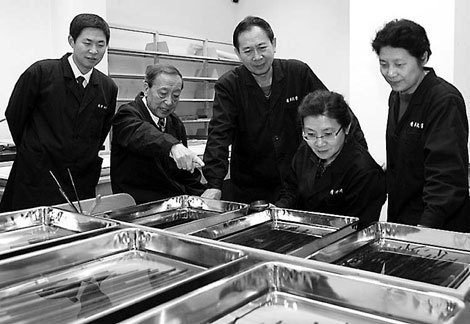 |
|
Professor Li Xueqin (second from the left) and other members of his research team at the lab with the ancient bamboo strips stored in distilled water. [Guo Haijun]
|
The discovery of more than 2,000 bamboo strips, dating back to the late Warring States Period (475-221 BC), is exciting historians for the light it can shed on early Chinese history. The 2,100 strips are now at Tsinghua University and were donated in July by a former pupil who wishes to remain anonymous.
Most words on the strips - some are as long as 46 cm and some a mere 10 cm - remain clear and neat. The short strips may have been used as "pocket books" that could be carried around more easily, says professor Li Xueqin, a leading historian at Tsinghua University.
Before the Eastern Han Dynasty (AD 25 - 220 AD) court official Cai Lun made possible China's gift of paper to the world in AD105, Chinese rulers and scholars relied largely on bamboo strips to write on.
The Tsinghua collection records history from the early Western Zhou Dynasty to the early Warring States Period (11th century BC - 5th century BC) and what makes it especially precious is the fact that much of the information on these strips is different from existing versions of early Chinese classics. Although experts have yet to decipher all the words, they believe these bamboo pieces are the missing historical links long considered lost to time.
Emperor Qinshihuang, the First Emperor of the Qin Dynasty (221-206 BC), established the first united empire in Chinese history. To consolidate his rule, he confiscated and burned many classics that he believed were potentially dangerous. Such incidents recurred throughout Chinese history. Wars and natural disasters also played their part in destroying the ancient classics.
"These bamboo strips are like a newly-found historian. Together, they make up one of the oldest books found so far in China," Li says.
When the bamboo strips first arrived at Tsinghua University in mid-July, they were wrapped in plastic and stored is some kind of liquid. Some strips had gone moldy.
Zhao Guifang, a cultural relics expert says they had rotted from lying buried for 2,000 years.
The experts first replaced the liquid with distilled water, changing it every two or three days. To clean the remaining dirt, they picked them up painstakingly with soft brushes. "Many soft brushes were worn out," Zhao says simply.
Bamboo strips are so vulnerable that "sometimes being covered with mold for several hours can completely destroy the writings on them", says Li. The long-term preservation of bamboo pieces used for writing remains a challenge not just in China but also throughout the world.
Like the preservation, deciphering the lettering on these bamboo strips also poses a tough challenge. Reading Chinese characters from the Warring States Period for today's Chinese is as difficult as understanding old English for today's native English speakers.
Yet, once scholars interpret their meanings, "we can present a truer picture of early Chinese history to the world", says Li. He is one of 11 experts picked for this job from Peking University, The Chinese University of Hong Kong, State Administration of Cultural Heritage and the Chinese Academy of Cultural Heritage.
Tsinghua University has even set up a Research and Preservation Center of Unearthed Documents for these bamboo strips.
"They are the treasure of the Chinese nation and the entire world. Tsinghua will invite experts from the whole world to preserve and study them," says university vice-president Xie Weihe.